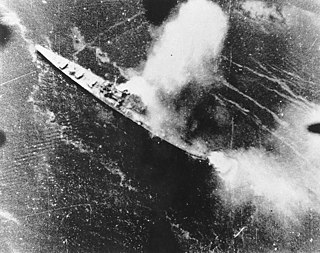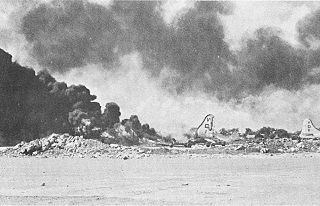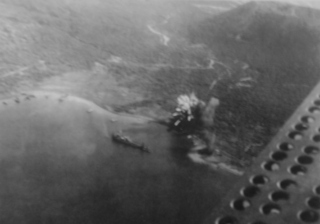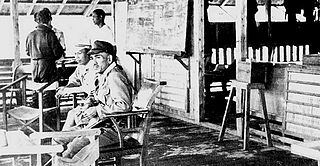This is a list of aviation-related events from 1940:
This is a list of aviation-related events from 1941:
This is a list of aviation-related events from 1944:
This is a list of aviation-related events from 1942:
This is a list of aviation-related events from 1945:

The Battle of the Bismarck Sea took place in the South West Pacific Area (SWPA) during World War II when aircraft of the U.S. Fifth Air Force and the Royal Australian Air Force (RAAF) attacked a Japanese convoy carrying troops to Lae, New Guinea. Most of the Japanese task force was destroyed, and Japanese troop losses were heavy.

The bombing of Rabaul in November 1943 was an air attack conducted by the Allies of World War II upon a cruiser force at the major Japanese base of Rabaul. In response to the Allied invasion of Bougainville, the Japanese had brought a strong cruiser force down to Rabaul from Truk, their major naval base in the Caroline Islands about 800 miles north of Rabaul in preparation for a night engagement against the Allied supply and support shipping. Allied carrier- and land-based planes attacked the Japanese ships, airfields, and port facilities on the island of New Britain to protect the Allied amphibious invasion of Bougainville. As a result of the Rabaul raids, the Japanese naval forces could no longer threaten the landings. The success of the raid began to change the strongly held belief that carrier-based air forces could not challenge land-based air forces.

The New Guinea campaign of the Pacific War lasted from January 1942 until the end of the war in August 1945. During the initial phase in early 1942, the Empire of Japan invaded the Territory of New Guinea on 23 January and Territory of Papua on 21 July and overran western New Guinea beginning on 29 March. During the second phase, lasting from late 1942 until the Japanese surrender, the Allies—consisting primarily of Australian forces—cleared the Japanese first from Papua, then New Guinea, and finally from the Dutch colony.

The Invasion of Lingayen Gulf, 3–13 January 1945, was an Allied amphibious operation in the Philippines during World War II. In the early morning of 6 January 1945, a large Allied force commanded by Admiral Jesse B. Oldendorf began approaching the shores of Lingayen from Lingayen Gulf, on the island of Luzon. U.S. Navy and Royal Australian Navy warships began bombarding suspected Japanese positions along the coast of Lingayen from their position in Lingayen Gulf for three days. On "S-Day", 9 January, the U.S. 6th Army landed on a roughly 25 mi (40 km) beachhead at the base of the Gulf between the towns of Lingayen and San Fabian.

Miles Rutherford Browning was an officer in the United States Navy in the Atlantic during World War I and in the Pacific during World War II. An early test pilot in the development of carrier-based Navy aircraft and a pioneer in the development of aircraft carrier combat operations concepts, he is noted for his aggressive aerial warfare tactics as a Navy captain on the Admiral's staff aboard USS Enterprise and at Nouméa during World War II. His citation for the Distinguished Service Medal states: "His judicious planning and brilliant execution was largely responsible for the rout of the enemy Japanese fleet in the Battle of Midway." Naval historian Craig Symonds disagrees, however, writing that "the citation claim that Browning was 'largely responsible' for the American victory at Midway, an assertion that some historians have taken seriously. .. is manifestly untrue."

During the Pacific War, Allied forces conducted air raids on Japan from 1942 to 1945, causing extensive destruction to the country's cities and killing between 241,000 and 900,000 people. During the first years of the Pacific War these attacks were limited to the Doolittle Raid in April 1942 and small-scale raids on military positions in the Kuril Islands from mid-1943. Strategic bombing raids began in June 1944 and continued until the end of the war in August 1945. Allied naval and land-based tactical air units also attacked Japan during 1945.

The Landings at Cape Torokina, also known as Operation Cherryblossom, took place at the beginning of the Bougainville campaign in World War II. The amphibious landings were carried out by elements of the United States Marine Corps in November 1943 on Bougainville Island in the South Pacific, as part of Allied efforts to advance towards the main Japanese base around Rabaul under Operation Cartwheel. Coming in the wake of Allied successes at Guadalcanal and in the central Solomons, the landings were intended to secure a beachhead with the purpose of establishing several bases from which to project air and naval power closer towards Rabaul, in an effort to neutralize the large Japanese force that had been established there.

The Battle of Noemfoor was part of the New Guinea campaign of World War II. It took place on the island of Noemfoor, in Dutch New Guinea, between 2 July and 31 August 1944. During the battle, Allied forces landed on the island to capture Japanese bases as part of their advance through the Pacific towards the Philippines. The initial landing was largely unopposed and the Japanese defenders withdrew inland as the US troops came ashore. Sporadic fighting took place over the course of two months as the Allies secured the three airfields on the island and pushed the surviving Japanese troops to the southeastern coast. The island was later used by the Allies to support operations around Sansapor and on Morotai.

The bombing of Kure took place by allied aircraft during air raids on Japan in the Pacific War in 1945. These raids targeted the major naval base located at the city, ships moored at this base or nearby, industrial facilities, and the city's urban area itself.

Operation I-Go was an aerial counter-offensive launched by Imperial Japanese forces against Allied forces during the Solomon Islands and New Guinea campaigns in the Pacific Theater of World War II. Taking place from 1–16 April 1943, Japanese aircraft—primarily from Imperial Japanese Navy units under the command of Admirals Isoroku Yamamoto and Jinichi Kusaka—attacked Allied ships, aircraft, and land installations in the southeast Solomon Islands and New Guinea. The goal of the operation was to halt the Allied offensives to give Japan time to prepare a new set of defenses in response to recent defeats in the Guadalcanal campaign and in New Guinea at Buna–Gona, Wau, and the Bismarck Sea.

During World War II, a series of Japanese air attacks on the Mariana Islands took place between November 1944 and January 1945. These raids targeted United States Army Air Forces (USAAF) bases and sought to disrupt the bombing of Japan by Boeing B-29 Superfortress heavy bombers operating from the islands. The Japanese lost 37 aircraft during this operation, but destroyed 11 B-29s and damaged a further 43. Preparations were also made for commando raids on the bases in early and mid-1945 but these did not go ahead.

The neutralisation of Rabaul was an Allied campaign to render useless the Imperial Japanese base at Rabaul in eastern New Britain, Papua New Guinea. Japanese forces landed on Rabaul on 23 January 1942, capturing it by February 1942, after which the harbor and town were transformed into a major Japanese naval and air installation. The Japanese heavily relied on it, using it as a launching point for Japanese reinforcements to New Guinea and Guadalcanal. Throughout the Solomon Islands campaign, neutralizing Rabaul became the primary objective of the Allied effort in the Solomons.

The South China Sea raid was an operation conducted by the United States Third Fleet between 10 and 20 January 1945 during the Pacific War of World War II. The raid was undertaken to support the liberation of Luzon in the Philippines, and targeted Japanese warships, supply convoys and aircraft in the region.

The attack on Kure was an air raid conducted during the Pacific War by the United States Navy on 19 March 1945. It targeted the remnants of the Japanese Combined Fleet located in and near the Japanese city of Kure. The attack by 321 aircraft was unsuccessful, as no Japanese warships were sunk though several were damaged. Japanese forces struck the American fleet on the morning of 19 March, and crippled one aircraft carrier and badly damaged another.

Operation SO and SE were parts of an aerial offensive launched by Imperial Japanese forces against Allied forces staging around Guadalcanal area during the Solomon Islands Campaign in the Pacific Theater of World War II. The aerial offensive took place between 7 and 16 June 1943 and was aimed at destroying Allied air power and shipping. Operation SE involved airstrikes against Allied ships around Guadalcanal that were preparing for Invasion of New Georgia. It was preceded by the First and the Second Operation SO, which both involved fighter sweeps against Guadalcanal from several air groups of Imperial Japanese Navy Air Service. The resulting battles from these operations were dubbed as Lunga Air Battle by the Japanese.














